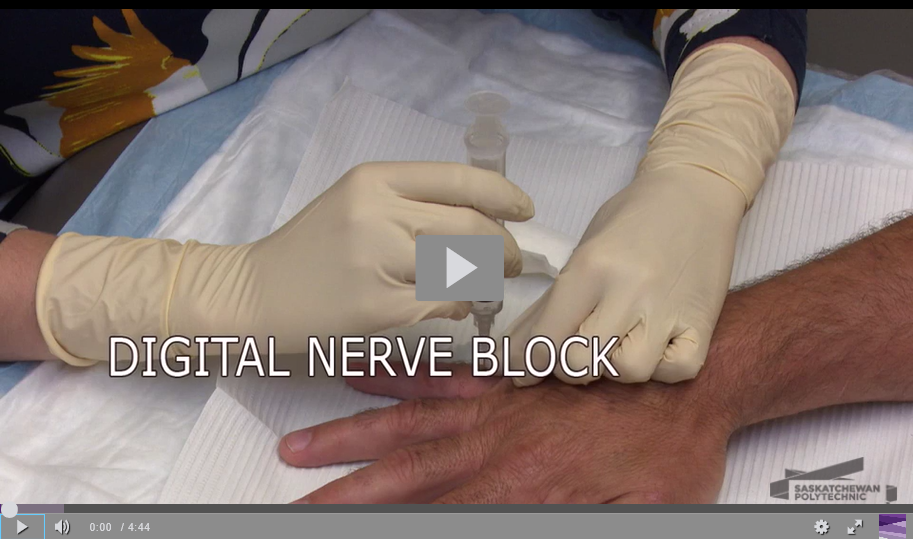Digital Nerve Block
Step 1: Health history and physical assessment
Health history:
- Focus on past experience with local or regional anesthesia and wound management, suturing, etc.
- Allergies
Physical assessment:
- Circulation, sensation and movement distal and proximal to the wound
- 2-point discrimination or sharp/dull discrimination
- Pulses and capillary refill
- Range of motion and strength against resistance of all body parts surrounding the wound site unless contraindicated by other injuries or existing pathology
- Pain
Step 2: Set up equipment, wash hands, don gloves
Step 3: Position patient
Step 4: Skin preparation
Reduce the risk of infection by preparing the skin with chlorhexidine solution. Cleanse both the injured area and the injection sites with the chlorhexidine solution.
An alternative option is to soak the digit in the cleansing solution for 5 minutes. Soaking may be preferred for digits that are inflamed or painful (ingrown nail or paronychia).
Step 5: Prepare anesthetic agent
- Avoid use of anesthetic agents with epinephrine. Epinephrine causes vasoconstriction and increases the risk of an ischemic injury to the digit.
- Use a small gauge needle (27 to 30-gauge) to reduce pain during injection.
- A total of 2-3 mL is usually sufficient to produce adequate anesthesia of the entire digit.
Step 6: Introduce needle at first injection site
- Do not inject directly into nerves. Hold the syringe perpendicular to the finger.
- Insert the needle into the web space at the base of the finger, just distal to the metacarpal/phalangeal (knuckle) joint.
- The procedure may be uncomfortable, but excessive pain or paresthesia suggests the needle is against a nerve and should be repositioned.
Step 7: Advance needle
Step 8: Gently pull on plunger of syringe
Step 9: Inject anesthesia
Step 10: Repeat steps 6 to 9 on the opposite side of the finger
Step 11: Test sensation
- Onset of anesthesia is typically within 5 minutes
- Full effect may require 10 to 15 minutes
- Anesthesia with xylocaine lasts about 30 to 40 minutes
- Ensure to test the nailbed and tip of digit for sensation if working on the nail
Digital Nerve Block of Great Toe
The procedure steps and principles for digital nerve block of the great toe are as above, but the great toe requires additional injection of anesthesia to the dorsum of the toe. The procedure below is referred to as the three-sided digital block.
- Inject lateral edge of the toe
a. Hold the syringe and needle perpendicular to the toe.
b. Slowly advance the needle straight through from the dorsal to plantar surface. Take care not to push the needle through the plantar surface skin.
c. Slowly inject 1-2mL of anesthetic as you advance or withdraw the needle. - Inject dorsum of toe
a. Partially withdraw the needle, leaving the tip inserted in the skin.
b. Redirect the needle across the dorsal aspect of the toe.
c. Inject 1-2mL from the lateral to medial aspect of toe dorsum. - Inject medial edge of the toe
a. Hold the syringe and needle perpendicular to the toe.
b. Enter the skin through the anesthetized area in step 2.
c. Slowly advance the needle straight through from the dorsal to plantar surface. Take care not to push the needle through the plantar surface skin.
d. Slowly inject 1-2mL of anesthetic as you advance or withdraw the needle.

